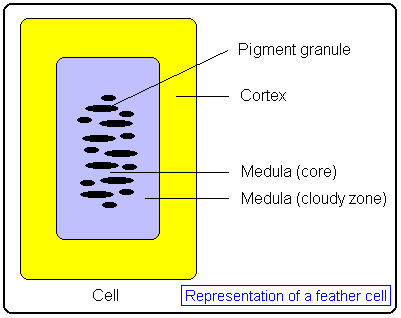|
It is general knowledge that budgerigar's colours come in three different shades: light, medium or dark. Following the same order, blue series birds are called sky blue, cobalt and mauve, while green series birds are called light green, dark green and olive green.
The locus that controls the shade shown by a bird is located on the same chromosome that carries the locus for yellow pigment production. For this reason, it is said that both these loci have a degree of linkage. The implications of such linkage shall be discussed later.
The wild-type gene for colour depth determines that the feathers will show the clearer shade. The mutation produces a darker depth of colour.
The locus for colour depth, also called the dark factor, does not produce an actual colour. The dark factor acts changing the depth of a pre-existing colour.
Symbols for allelomorphs
(according to Mutavi)
|
Gene type
|
Effect of the allelomorphs that control colour
depth
|
|
D+
|
Wild-type
|
Light shade
|
|
D
|
Mutant
|
Dark shade
|
Table 6 – Symbols and visual effect of the allelomorphs for colour depth
When an individual possesses one copy of the wild-type gene and one copy of the mutated gene, both produce visual effect on the phenotype. They are said to be incomplete dominant.
|
Genotype
|
Effect of the locus that controls
colour depth
|
|
D+ D+
|
Homozygous
wild-type
|
Light shade
|
|
D+ D
|
Heterozygous
|
Medium shade
|
|
D D
|
Homozygous
mutant
|
Dark shade
|
Table 7 – Visual effect of the pairs of allelomorphs that occupy the "colour depth" locus.
In heterozygous condition each gene partially expresses itself originating the medium shade.
The combined effects of the three loci discussed so far, originate a great number of phenotypes. Here are a few examples:
|
Genotype
|
Phenotype
|
|
Locus for melanin production
|
Locus for yellow pigment production
|
Locus for the
colour depth
|
|
dil+
dil+
|
bl+
bl+
|
D+ D+
|
Normal light green
|
|
dilgw dilgw
|
bl+
bl
|
D+ D
|
Greywing dark green
|
|
dilgw dil
|
bl1
bl1
|
D D
|
Greywing mauve
|
|
dil dil
|
bl2
bl2
|
D+ D+
|
Sky blue dilute
|
|
dil dil
|
bl1
bl2
|
D+ D
|
Yellowface cobalt dilute
|
|
dilcw dilcw
|
bl bl
|
D D
|
Clearwing mauve
|
|
dilcw dil
|
blgf
bl2
|
D D
|
Goldenface clearwing mauve
|
Table 8 - Examples of phenotypes originated by three different loci
The explanation for the different shades can be found analysing the microscopic structure of feathers. Feather barbs are made of cells. An external layer called the cortex and an internal layer called the medulla form each cell. Usually the core of the medulla is full of melanin granules while the external medulla, also called cloudy zone, is free from this pigment.

|
Light that reaches the medulla core is absorbed by the black melanin.
The dark factor affects the cloudy zone's width. The wild-type allelomorph, D+, causes the cloudy zone to be wider while the mutation, D, causes the cloudy zone to be thinner.
Light passes through the cortex and reaches the cloudy zone where some of the radiation
|
is reflected back and becomes visible to the observer. The black melanin granules absorb the fraction of light that passes through the cloudy zone.
The wider the cloudy zone is, the greater is the fraction of light reflected towards the exterior of the cell, giving the observer the perception of a lighter shade. This is the effect wild-type, D+, allele. The mutant, D, allele causes the reverse effect, the cloudy zone becomes thinner so a smaller fraction of light is reflected giving the observer the perception of a darker shade.
|





![]()
![]()
![]()
![]()
![]()